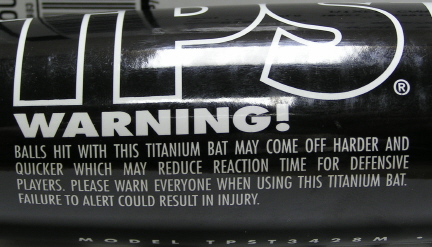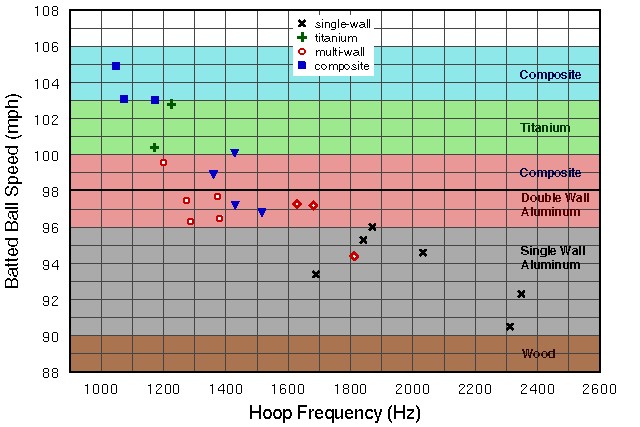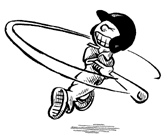y bgcolor=white>
Today is The contents of this page were last modified on September 7, 2005
Why are Titanium Bats Illegal?
Titanium bats made a very short-lived foray into the world of slow-pitch softball during the spring and summer of 1993. However, in spite of their short duration they had an immediate and long-lasting impact on the game. Most of the existing performance standards and many current issues regarding safety in softball are the direct result of the effect that titanium bats had on the game of slow-pitch softball.
Manufacturers had long known that the thinner they could make the walls of a softball bat, the greater the trampoline effect, and the faster the speed with which balls come of the bat.[1] However, limitations in the durability of available aluminum alloys meant that if they made the walls too thin, the bat would dent or crack open upon impact with a ball. Double-walled aluminum bats, first introduced by DeMarini in 1996, use two thin aluminum tubes one inside the other. The thinner walls increases performance, while the two walls together provide an increase in strength. However, even with advances in aluminum alloys and manufacturing processes, single-walled aluminum bats have reached a compromise between maximum possible performance and durability. Enter the titanium bat. The high strength to weight ratio of titanium means that a very durable single-walled bat could be made with thinner walls than is possible with aluminum. This means a phenomenally improved trampoline effect and when Titanium bats were introduced players were hitting balls upwards of 10mph faster (about 40-50 feet farther) then they could with aluminum bats. This sudden surge in performance immediately caught the attention of softball organizations like the United States Slow-pitch Softball Association (USSSA) and the Amateur Softball Association (ASA) who began discussing ways to limit the performance of softball bats. The long range result was bat performance standards, but the immediate result was a complete ban on titanium bats.
What Titanium Bat Models Exist?
 Easton Titanium Typhoon
Easton was the first bat maker to introduce a titanium bat into the slow-pitch softball market in 1993. Their STI1 Titamium Typhoon had a barrel made from a sheet of 0.053" thick Titanium which was rolled into a tube and welded (if you look closely can see a thin seam down the length of the barrel). They originally retailed for about $500 and while one source[2] says 5000 bats were produced, I tested one which had the marking 175/2500 1993 handwritten on the barrel underneath the shiny finish of the bat. The Typhoon I currently have in the lab does not have any number markings. So, I'm guessing there were two runs of 2500, the first of which may have been identified with a bat ID number.
I have seen a followup version model, the STI2 Typhoon II (with blue graphics). I have been told this bat never actually made it into large scale production and only a handful (less than a dozen) purportedly exist. The only one I have seen was cracked while being tested in a laboratory to measure its performance according to the high speed test used by the ASA to certify slow-pitch softball bats starting in 2004.[3] The ASA has imposed a maximum Batted-Ball Speed of 98mph with this test using a .44COR 375lb ball. The blue Typhoon II produced a whopping 111mph before breaking (a 30oz original red Typhoon hit 102.5mph, while a single-walled aluminum bat from 1993 hit around 94 mph). I haven't had the opportunity to test this myself yet, but I've read that the titanium bats are even more amazing when used with the more elastic balls from the 1993 time period.
The photo below shows the two Easton Typhoon titanium bats that were tested when the ASA 2004 performance test was being developed. The ID number of the original Typhoon (red graphics) is just visible below the rings on the taper region. The crack in the Typhoon II bat (blue graphics) is visible right in the middle of the word "Titanium" on the barrel.

|
 Worth Titanium Ti51
Worth had actually developed their TI51 titanium bat in 1988 but kept it under wraps for five years because they knew how much of an impact it would have on the game.[4] They only introduced their titanium bat into the market in 1993 because Easton started selling the Typhoon. The Worth Ti51 is a 0.051" thin 15-3-3-3 seamless tube, and was the first titanium bat to have an aluminum knob welded to the handle. The Ti51 sold for $700 and there were 3000 made in the first production run. Apparently due to popular demand there was a second run (Titanium 2) and a third run (Stinger) but I have not yet had the opportunity to get my hands on either of these, though I have had a chance to play with and test an original Worth Ti51.
|
 Louisville Slugger TPS Titanium
The Louisville Slugger TPS Titanium is also a 0.051" thin 15-3-3-3 seamless tube, from the same supplier as the Worth Ti51. But, Louisville Slugger used a specially designed endcap to plug the barrel, which some players have said makes this titanium bat perform slightly better than the others. I've read that only 1500 were made and while most went to sponsor teams, they did retail for about $800. I currently have two of these in my lab for testing.
 All of three manufacturers attached a warning to the plastic wrapper of their titanium bats that said something like:
All of three manufacturers attached a warning to the plastic wrapper of their titanium bats that said something like:
| WARNING! Tests indicate that balls hit with a titanium bat, such as as this one, come off the bat harder and quicker than bats made of wood or aluminum. Defensive players may have less time to react. Before using this bat, you should alert all players, participants, coaches, umpires, and spectators that the ball may come off this bat harder and quicker than when using bats made of different materials. Failur to alert could result in injury. Use only with skilled players and where approved for play. |
But only Louisville Slugger, knowing their bat was so hot that unsuspecting pitchers and infielders might be caught unawares, actually began printing the warning right on the bat barrel as part of the graphics. The very first TPS Titanium bats did not carry the warning, but most of the bats which can still be found carry the printed warning as shown in the photo at right.
|
Toloso Maximus
 A few years ago, a couple of metallurgists, who also loved hitting the long ball in softball games, set out to begin making an extremely high performance bat for those players who do wish to play with bats not restricted by performance limits or safety regulations. Their efforts resulted in the Toloso Maximus, the first double-walled titanium softball bat. This bat is not approved for play by any of the softball associations, and is designed for those who are aware of the safety issues and who still want to play with a ridiculously hot bat. The Toloso Maximus has a 0.050" Titanium outer shell with carbon fiber inner wall. Double-wall design provides durability, and makes the bat produced a "crack" instead of the charactistic loud "ping" of other titanium bats. The maximus also has a thinner handle - 13/16" thick with 0.050" wall instead of being 0.075" thick like most aluminum bats. This results in less mass in the handle and moves balance point further out, increaseing MOI for and end-loaded effect. The Maximus retails for $595, but only 1000 are being made and as of May 2005 only 50 or so were still avialable. Apparently the Toloso bat makers are soon going introduce a new single-walled titanium bat.
A few years ago, a couple of metallurgists, who also loved hitting the long ball in softball games, set out to begin making an extremely high performance bat for those players who do wish to play with bats not restricted by performance limits or safety regulations. Their efforts resulted in the Toloso Maximus, the first double-walled titanium softball bat. This bat is not approved for play by any of the softball associations, and is designed for those who are aware of the safety issues and who still want to play with a ridiculously hot bat. The Toloso Maximus has a 0.050" Titanium outer shell with carbon fiber inner wall. Double-wall design provides durability, and makes the bat produced a "crack" instead of the charactistic loud "ping" of other titanium bats. The maximus also has a thinner handle - 13/16" thick with 0.050" wall instead of being 0.075" thick like most aluminum bats. This results in less mass in the handle and moves balance point further out, increaseing MOI for and end-loaded effect. The Maximus retails for $595, but only 1000 are being made and as of May 2005 only 50 or so were still avialable. Apparently the Toloso bat makers are soon going introduce a new single-walled titanium bat.
|
Are Titanium Bats the Highest Performing Bats Ever?
It is true that titanium bats hit the ball much harder and faster than aluminum single-walled bats can, especially aluminum single-walled bats from the early 1990's. However, there are some recent extremely high performance composite slow-pitch softball bats, namely the Miken Ultra and Ultra II and the Easton Synergy (first production run) which significantly outperform titanium bats.[5,6]
 The plot at right is discussed in more detail in my webarticle comparing composite and aluminum bats as well in reference [5], and shows a comparison of performance values for a variety of aluminum single-walled, double-walled, composite and titanium bats. The vertical axis is performance in terms of a Batted-Ball Speed,* and represents the speed with which a 375lb/.44cor ball would leave the bat when hit by a class A slow-pitch player. The horizontal axis represents the frequency of the barrel mode of vibration which is primarily responsible for the trampoline effect, and as such represents a relative comparison of the "springiness" of the bat barrel. Notice that lower hoop frequency correlates to higher performance.
The plot at right is discussed in more detail in my webarticle comparing composite and aluminum bats as well in reference [5], and shows a comparison of performance values for a variety of aluminum single-walled, double-walled, composite and titanium bats. The vertical axis is performance in terms of a Batted-Ball Speed,* and represents the speed with which a 375lb/.44cor ball would leave the bat when hit by a class A slow-pitch player. The horizontal axis represents the frequency of the barrel mode of vibration which is primarily responsible for the trampoline effect, and as such represents a relative comparison of the "springiness" of the bat barrel. Notice that lower hoop frequency correlates to higher performance.
The plot shows that the original titanium bats (Easton Typhoon, Worth TI and Lousiville Slugger TPS) are capable of producing batted-ball speeds between 100-103 mph when hitting 375lb/0.44cor balls. This is approximately 10 mph faster than single-walled aluminum bats from the 1990's are capable of when hitting the same balls. Composite bats cover the entire range of performance, due to the considerable ease with which one can manipulate the composite material properties, and there are some very low performing composite bats as well as others which perform similarly to single-wall and double-wall aluminum bats. However, there are a few very high performance bats which according to both laboratory tests[5] and field trials[6] hit 375lb/0.44cor balls harder and faster than titanium bats, achieving batted-ball speeds as high as 107 mph. Three such bats, the Miken Ultra and Ultra II and the Easton Synergy, have been banned by most - if not all - softball associations and are no longer manufactured. In fact, when the Miken Ultra was first banned in 2003, several softball associations threatened to completely ban all composite bats. So, while titanium bats are very high performance bats, and while they had a lasting impact on the game despite their short appearance on the market, there have been recent improvements in composite bat technology which have surpased titanium bats. As a caveat, I should point out that the balls which were used back in 1993 when titanium bats were introduced were apparently much more lively than the 375lb/0.44cor balls currently used in ASA sanctioned play. I have not yet seen a comparison of performance for titanium bats and composite bats using livelier balls (like a 575lb/0.50cor) so I cannot say how the bats would compare with each other using more lively balls. I have also not seen any performance data for the Toloso Maximus bat so I cannot compare it to composite or original titanium bats. However, I have heard from players who have swung with the Toloso Maximums who say that it is an extremely high performing bat.
* The batted-ball speed (BBS) performance metric is defined by ASTM standard F2219. To measure BBS, a 375lb/0.44cor ball is fired from a cannon at a speed of 110mph towards a stationary bat. The ratio of the rebounding speed of the ball to its initial speed is combined with the impact location and the moment-of-inertia of the bat to produce a batted-ball speed representative of what a good player would actually achieve in the field. When the F2219 standard was being developed, the data was correlated to field trials at a national ASA tournament in order to ensure that the BBS values resulting from the test represent realistic performance in the field.
References
[1] S. Ashley, "Getting Good Wood (or Aluminum) on the Ball," Mechanical Engineering, 112(10), 40-47 (1990).
[2] History of the Titanium Bat, at the Toloso.com website (makers of the Toloso Maximums double-walled titanium softball bat).
[3] ASTM F2219-04: Standard Test Methods for Measuring High Speed Bat Performance.
[4] L. Pavlovich, "Veteran aluminum bat designer Jess Heald warns coaches about `super bat'," Collegiate Baseball, 38(4), p.8 (1995).
[5] D.A. Russell, "Hoop frequency as a predictor of performance for softball bats," Engineering of Sport 5, Vol. 2, pp. 641-647 (International Sports Engineering Association, 2004).
[6] M. McDowell and M.V. Ciocco, "A controlled study on batted ball speed and available pitcher reaction time in slowpitch softball," Br. J. Sports. Med., 39, 223-225 (2005).
Back to Physics and Acoustics of Baseball & Softball Bats




 The plot at right is discussed in more detail in my webarticle comparing composite and aluminum bats as well in reference [5], and shows a comparison of performance values for a variety of aluminum single-walled, double-walled, composite and titanium bats. The vertical axis is performance in terms of a Batted-Ball Speed,* and represents the speed with which a 375lb/.44cor ball would leave the bat when hit by a class A slow-pitch player. The horizontal axis represents the frequency of the barrel mode of vibration which is primarily responsible for the trampoline effect, and as such represents a relative comparison of the "springiness" of the bat barrel. Notice that lower hoop frequency correlates to higher performance.
The plot at right is discussed in more detail in my webarticle comparing composite and aluminum bats as well in reference [5], and shows a comparison of performance values for a variety of aluminum single-walled, double-walled, composite and titanium bats. The vertical axis is performance in terms of a Batted-Ball Speed,* and represents the speed with which a 375lb/.44cor ball would leave the bat when hit by a class A slow-pitch player. The horizontal axis represents the frequency of the barrel mode of vibration which is primarily responsible for the trampoline effect, and as such represents a relative comparison of the "springiness" of the bat barrel. Notice that lower hoop frequency correlates to higher performance.